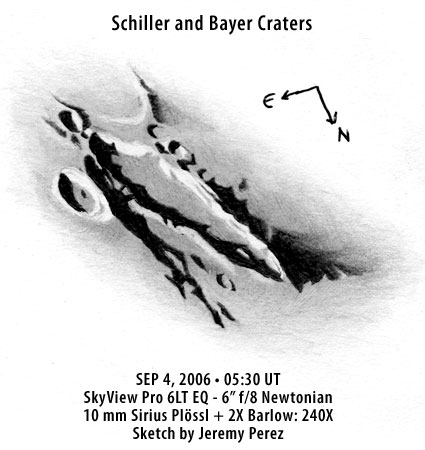
Observation Notes:
This was my first lunar sketch in a lonnnng time. Schiller was very nicely placed. Its northern stretch was in the thickest shadow with one mountain peak illuminated. A ridge peeled away from the southeast side of the crater and was bounded by Bayer on the other side. The crater floor was smooth and dark. Due to its position near the limb, there is surely a lot of perspective making it seem even more elongated than it really is. I can imagine multiple impacts generating Schiller’s oval shape.
Object Information:
Shiller is a steep walled, 171 km x 71 km plain with a larger, smooth souther portion that narrows to the north. The northern section is crossed by two large north-south ridges.
| Subject | Schiller and Bayer Craters |
| Classification | Crater |
| Position | Southwest |
| Phase/Age | 11.4 days old |
| Size* | Schiller: 171 x 71 km Bayer: 46 km |
| Date/Time | September 3, 2006, 10:30 – 11:45 PM MST (September 4, 2006, 05:30 – 06:45 UT) |
| Observing Loc. | Flagstaff, AZ – Home |
| Instrument | Orion SVP 6LT Reflector (150 mm dia./1200 mm F/L) |
| Eyepieces/Mag. | 10 mm + 2X Barlow (240X) |
| Conditions | Partly cloudy, calm |
| Seeing | Ant. IV |
| Sources | The Moon Observer’s Guide By Peter Grego Virtual Moon Atlas |
* Based on published data.
Jeremy, this is a fantastic sketch of the lunar craters Schiller & Bayer. Way cool!
I know you are fond of the SEDS website for information on Deep-Sky objects, but are you aware of Wikipedia’s excellent section on lunar craters?
Here are the entries for Schiller and Bayer. Here is the index page List of craters on the Moon.
Thanks for posting this sketch (and the Double Stars below look fabulous as well)!
Eric
Eric, thanks very much!
Actually, I was very tempted to use info from Wikipedia to describe these craters better. But I’m not sure how trusted Wikipedia is as a resource for lunar data. It certainly seems very useful, with crater dimensions, depths, longitude & latitude, along with other geological info. I notice that they reference a bibliographic list for their data, but for an individual crater such as Bayer, you don’t know which specific resource they’ve used. So far, the only lunar resources I have are Grego’s Moon Observer’s Guide, and the Virtual Moon Atlas. So I can’t cross check the data with other books to be sure it’s accurate.
Apart from getting a few more lunar books, it sounds like its time I found out how other lunar observers feel about Wikipedia’s data. Thanks for the suggestion!
Jeremy
Honestly, I’m not sure how reliable Wiki is either, but its obvious someone put a lot effort into the lunar section there, and I’ve yet to find anything rings that false to me (but I’m hardly a lunar expert!) Perhaps Rich Handy or one of the other folks at CN’s lunar forum could provide a more informed opinion…
It does seem like a more comprehensive treatment of the subject (in terms of features detailed) than I’ve seen elsewhere, either online or in print.
Eric
Absolutely. The amount of effort that’s been put into it as a searchable resource is fantastic. I think I’ll start a thread in the CloudyNights Lunar forum just to see what the broader consensus is, because I’d love to reference it directly.
Over the past few months, I’ve been surprised to notice my site being cited (heh) at Wikipedia as “Basic data on abc” or “Position and other data on xyz”, and I’ve had a couple Woaahhh Nelly moments over that (NGC 1514 and NGC 3384). I’m not sure how comfortable I am being cited for ‘data’. Being cited for ‘visual observations’ or ‘sketches’ or ‘what can be _seen_ with a 6 inch scope’, etc. works great for me. But it’s caused me to be a lot more cautious about where I get my info. I’ve stopped using compiled, online observing lists that come up on Google for example 😮 , because there have been a couple instances where I’ve traced bad double star info all over the web to some outdated/plain wrong data on a particular double star observing list out there. I’d hate to become another source for bad info. Particularly if I’m going to start building up circular references at Wikipedia 😀
Anyway, once I get a feel for how folks feel about the lunar data there, I’d be pretty eager to start incorporating and referencing it with the observations I post here.
Your sketch brought back some memories. In your sketch you show three shadows on the eastern rim of Schiller. I couldn’t rememebr when or where it was and I asked my observing partner if he remembered. I suggested that he stop by to see this drawing – in addition the others!
Turns out it was crater Bailly but your drawing struck a nerve. My notes of that session describe something very similar: Three broad shadows ribbed along the southern rim of crater Bailly like pinstripes.
I’ll take the drawings over photos anyday. Thanks for sharing these.
peter
Hi Peter, thanks for the comment. I think the constantly changing play of shadows near the lunar terminator is fascinating. I also end up finding unexpected alignments of light and dark that catch my eye immediately.
I continue to enjoy the posts at your site. Keep up the great work at Central Park!